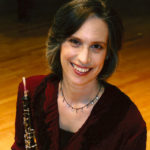Longitude Sound Bytes
Ep 61: Creating presence is a dynamic process | Janet Rarick – by Shvetali Thatte (Listen)
My name is Shvetali Thatte, a Longitude fellow from Case Western Reserve University, and today I will be presenting a sound byte by Janet Rarick, a professor at Rice University’s Shepherd School of Music. Janet will be speaking about cultivating presence in her life, and she’ll be taking us through a technique that she frequently uses to explore presence in her daily life.

Janet Rarick, Professor at Rice University Shepherd School of Music:
Hello, everyone. My name is Janet Rarick. I’m a professor at Rice University’s Shepherd School of Music. In past years I enjoyed a vibrant career as a performing oboist. As a performer, I became interested in finding ways to be more present in my work. Now as a teacher, I work with our music students on advancing their careers and improving their performance skills. So how can you cultivate presence in your life? Several years ago, I trained to become a teacher of the Alexander Technique. The technique is useful in exploring presence. It shares concepts with other disciplines that cultivate presence such as mindfulness, and sports psychology.
Creating presence is a dynamic process, where you choose to open up your attention to the here and now. It is important to let go of judgment and critical thought. Evaluating yourself or others takes you right out of the present moment. Now, let’s experiment with coming into the present moment.
First, take a moment to thank yourself for taking the time to explore presence. Balance over your feet in a dynamic way, so that you could move easily to another position. If you’re sitting in a chair, move your feet to a slightly different place. We are going to think about opening up our sensory perception. So activate your peripheral vision. Notice the space all around you – 360 degrees space around your entire body. Notice your breath. Think of a little smile behind your eyes and let go of any tendency to do this correctly. No judgement, right? Notice the spaces between the places in your visual field. Sense the floor beneath your feet. Imagine all of the space behind you. If you are standing, take a short walk around the room and breathe. You have all the time in the world in this moment. Come back to sensing your whole 360 degree self. Remember that everyone struggles with distraction. So be grateful that you have taken the time to come to the present moment. You can also practice this exploration with routine activities when our attention tends to go off task to autopilot. Such as brushing your teeth, standing at the sink, working at the computer. Take a short break and enjoy being present. I hope you enjoyed exploring presence.

Shvetali Thatte, Longitude fellow, Case Western Reserve University:
Thank you so much for such a lovely presentation, Janet.
I couldn’t agree more on this idea of creating presence in her life. As a college student, I can attest that it’s often easy to get lost in the whirlwind of assignments, compounded by the brief moments of laughter with friends. Time often blurs together. And it’s difficult to find myself truly appreciating the present moment, as the back of my head is frequently thinking about my to do list, or what I’m going to do later that day. As you said, coming to senses in our present moment, can help us be grateful for what we have. And it can alleviate our stress as we embrace the moment rather than worrying about what the future may bring. Personally, I try to appreciate the present by making a gratitude list every night. Before I fall asleep, I take five minutes to write down five things that I’m grateful for in the moment. And I do this without thinking. So it’s always the first five things that come to my mind. I also take a few minutes to stretch every night. And during this time, I focus on my breath. I’ve found that when I think about my breath and become aware of my body, I can get out of my head. And doing so allows me to focus in the present moment and where I physically am, as opposed to wherever my wandering mind might take me.
We’re running out of time, but I’m so glad you walked us all through this technique of cultivating presence. And I can certainly say that I will be using it in the future.
We hope you enjoyed today’s segment and felt inspired to continue your journey towards finding your moments of presence in life. Please feel free to share your thoughts over social media and in the comments, or write to us at podcast@longitude.site. We would love to hear from you. Join us next time for more unique insights and Longitude Sound Bytes.
